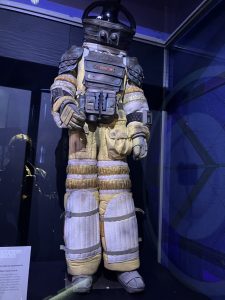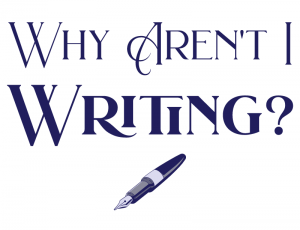Hi there,
Welcome to this week’s Word Count! It’s been a delightfully science fictiony week which has taken me right back to my reading roots and reinvigorated my love of SF.
Event: The Clarke Award 2022
I grew up on science fiction, graduating at some point in my early teens from Nancy Drew to my Dad’s collection of mid-century SF paperbacks. I’d read anything and everything, from AE van Vogt to Robert Heinlein to EE Doc Smith and everything in between (though sadly, there were no female writers in Dad’s collection).
When I first had the chance to go to the Arthur C Clarke Award ceremony, many years ago, I was delighted. I’m not going to say Clarke is my favourite SF writer – that honour belongs to Anne McCaffrey – but I still love science fiction and I love seeing modern SF celebrated.
Last Wednesday, the Science Museum hosted the 36th award ceremony and the first in-person ceremony for three years. The winner was Deep Wheel Orcadia, a novel that sounds utterly fascinating: “a science-fiction verse-novel written in the Orkney dialect. This unique adventure in minority language poetry comes with a parallel translation into playful and vivid English, so the reader will miss no nuance of the original.” Congratulations to author Harry Josephine Giles.
Clarke Award director Tom Hunter did a spectacular job of organising the event, even arranging for attendees to visit the special exhibition, Science Fiction: Voyage To The Edge of Imagination. (More on that below).
Congratulations must also go to the other shortlisted authors:
- Klara and the Sun – Kazuo Ishiguro
- A Desolation Called Peace – Arkady Martine
- A River Called Time – Courttia Newland
- Wergen: The Alien Love War – Mercurio D. Rivera
- Skyward Inn – Aliya Whiteley
That’s my reading list sorted!
Event: Science Fiction at the Science Museum
Science Fiction: Voyage To The Edge of Imagination (tickets £20) has recently opened at the Science Museum and I was lucky enough to be able to go, ahead of The Clarke Award ceremony.
The exhibit is a fun romp through various aspects of science fiction. You’re guided through by short monologues from an alien AI seeking to understand what humans mean when we talk about ‘science fiction’. Funnily enough, I’ve been thinking about that a lot myself, recently. (More on that below, again!)
The exhibit has some really fabulous artefacts, including some original props from various iconic films and TV shows. I loved the EVA suits from Sunshine and Alien, just to see the variation in how EVA suits have been imagined compared to how they were built for the Apollo mission. They also have Nichelle Nichol/Lt Nyota Uhura’s uniform from Star Trek: The Motion Picture, and a replica tricorder.
I arrived a bit later than I wanted to, so had to rush through a little bit as I was worried about missing the ceremony, but it was a fun exhibit. I suspect I’ll go back with my husband and take it all in much more slowly.
 |
 |
Book reviews: The Martian and Project Hail Mary by Andy Weir
 I’ve been intending to read Andy Weir’s The Martian since hearing him interviewed by Francesca Steele in Ep 2 of her Write-Off podcast. I’ve also been intending to unpack the final boxes of books that were marked for the house, rather than storage, and bingo, there was my copy.
I’ve been intending to read Andy Weir’s The Martian since hearing him interviewed by Francesca Steele in Ep 2 of her Write-Off podcast. I’ve also been intending to unpack the final boxes of books that were marked for the house, rather than storage, and bingo, there was my copy.
I’ve seen the film, so I know what happens, but I still really enjoyed the book. There’s enough tension to keep you turning the pages, but enough humour to leaven the suspense. Not all of the plot from the book made it into the film, which meant that there were a few surprises for me, especially in the final third. The book also leans harder into the science, so there’s a lot more detail about the problems Mark Watney encounters and how he solves them than in the film.
Project Hail Mary is Weir’s third book and its set-up is very similar to The Martian: A man has to use every last scrap of scientific knowledge he has to survive in space. The protagonist, Dr Ryland Grace, is very similar in personality to Mark Watney, the basic plot for both books is very similar, and Weir’s approach to the science is similar, but that’s not a bad thing at all, because why break something that works so well?
Grace has a lot more to deal with than Watney – he’s not just got to save himself, he’s also got to save humanity from a star-munching galactic bacteria. And just when you think he’s managing that, things all get quite significantly more interesting.
Project Hail Mary has a much more bittersweet ending than The Martian, not to mention more emotional depth. Grace stops being so concerned about his own survival and focuses more on other people’s wellbeing, which is a significant part of his character development, (something The Martian lacks).
If you loved The Martian, you’ll love Project Hail Mary. If you haven’t read either but love science, then I expect you’ll enjoy both of them.
Science fiction vs science in fiction
Inspired by The Martian and Project Hail Mary, I have spent the last week or so mulling over a question that has been lurking in my head for many years. Is there a difference between science fiction and fiction with science in it?
I finally sat down and thrashed the question out in a blog post, which helped me not just understand what I was really asking, but why it has bothered me for the best part of a decade. Because it’s not just about whether we should have another genre, a sort of ‘meta-genre’ that collects together all fiction with science in it regardless of whether it’s ‘science fiction’, it’s about why we should care about including more science in all sorts of fiction. Read more!
Obligatory cat picture
 OK, this might be slightly cheating, but I couldn’t resist!
OK, this might be slightly cheating, but I couldn’t resist!
This little kitty was near the entrance to the Science Fiction: Voyage To The Edge of Imagination exhibit at the Science Museum, so it’s obvious I had to include him! I didn’t see a note to explain his presence, but I’m assuming that he is Orion from Men in Black.
The most famous cat in science fiction has to be Alien’s Jonesy, but he was a solid ginger tabby and didn’t have white socks, so it can’t be him!
All the best,
Suw
{ Comments on this entry are closed }




